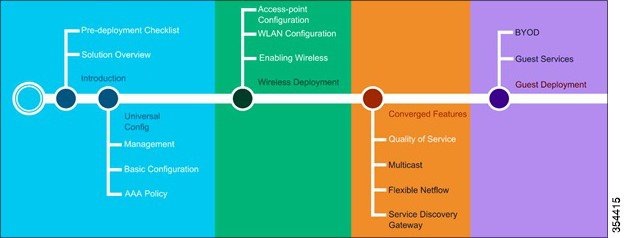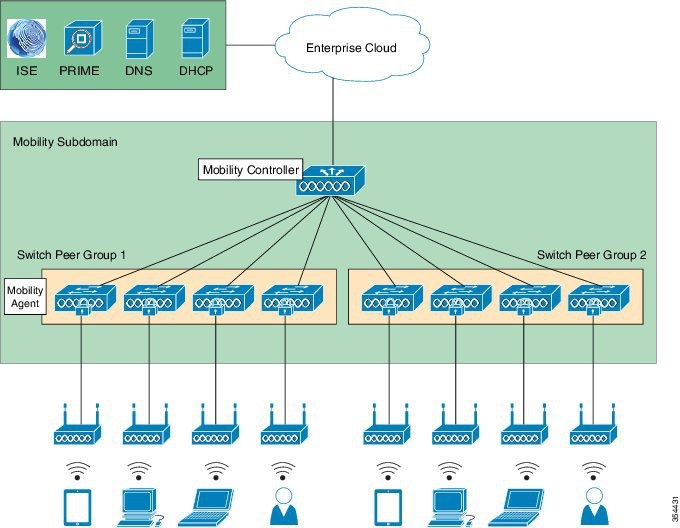- Converged Access: Solution Overview
- Converged Access: Predeployment Checklist
- Converged Access: Management
- Converged Access: Basic Configuration
- Converged Access: Securing Networks with AAA and Cisco ISE
- Converged Access: Enabling Wireless
- Converged Access: WLAN Configuration
- Converged Access: Wireless AP and RF
- Converged Access: Wireless QoS
Converged Access: Solution Overview
Converged access represents an architectural change in the way wired and wireless networks are deployed. A converged access network allows policy decisions to be enforced at the network edge, potentially minimizes unnecessary traffic backhaul, and simplifies network management by allowing one policy to be used for both wired and wireless traffic.
This chapter provides step-by-step instructions to deploy a converged access network with the commonly recommended features and configurations. This guide provides information about how to deploy an operating converged access network.
The following figure represents the converged access workflow. The items in white are the topics covered in this guide. The items in dark gray are the work-in-progress topics that will be added to the guide subsequently.

- Supported Platforms
- Recommended Software
- Prerequisites for Converged Access Deployment Guide
- Concepts and Definitions
- Converged Access Topology Example
- Supported Platform Product Identifiers
- Supported Wireless Access Point Models
Supported Platforms
-
Cisco Catalyst 3650 Series Switches
-
Cisco Catalyst 3850 Series Switches
-
Cisco 5760 Wireless LAN Controller
-
Cisco Catalyst 4500E Supervisor Engine 8E
The Cisco Catalyst 3650 Series Switches and Cisco Catalyst 3850 Series Switches provide converged wired and wireless network access for devices. Choose a specific switch based on the number of ports and uplink type and capacity required, type of ports, scalability requirement, and Power of Ethernet (PoE) capability needs of the network. The choice of the network uplink module is optional and depends on network requirements.
 Note | On Cisco Catalyst 4500 Series Switches, the 7R-E chassis should be hardware revision 2 or higher to house a Supervisor Engine 8E. |
 Note | Install boot is a prerequisite on Cisco Catalyst 4500 Series Switches, to support wireless. |
 Note | For more information about the Cisco Catalyst Series switches, see the Release Notes document at: http://www.cisco.com/c/en/us/td/docs/switches/lan/catalyst3850/software/release/3e/release_notes/OL3262101.html |
Recommended Software
The recommended software for Converged Access Deployment Guide is Cisco IOS XE Release 3.7.3 E.
 Note | The support for Supervisor Engine 8E on Cisco Catalyst 4500 Series Switches was added in Cisco IOS XE Release 3.8 E. On Cisco Catalyst 4500E, the 7R-E chassis should be hardware revision 2 or higher to house a Supervisor Engine 8E. |
 Note | Starting with Cisco IOS 12.2(31)SGA, ISSU is supported on Cisco Catalyst 4500 Series Switches. For more information, refer to Catalyst 4500 Series Switch Software Configuration Guide, IOS XE 3.8.0E and IOS 15.2(4)E |
The latest software releases are available on the Cisco website at:
http://software.cisco.com/download/navigator.html.
We recommend that you read the relevant Release Notes before upgrading to a given software release.
Prerequisites for Converged Access Deployment Guide
CLI and Console Access
-
Knowledge about converged access as a deployment model is essential. For more information about the overall solution and offering, see the following links:
-
Knowledge about converged access as a deployment model for delivery of wired and wireless services.
-
The person performing the deployment should be a Cisco Certified Network Associate (CCNA), and possess knowledge about wired and wireless services.
Before you configure a switch or controller for basic operations, you must connect it to a PC that uses a VT-100 terminal emulator (such as, HyperTerminal, ProComm, or Putty). A controller has both EIA and TIA-232 asynchronous (RJ-45), and USB 5-pin mini Type B, 2.0-compliant serial console ports. The default parameters for the console ports are 9600 baud, 8 data bits, 1 stop bit, and no parity. The console ports do not support hardware flow control. Choose a serial baud rate of 9600 or 115200.
The GUI must be used on a PC that is running Windows 8, Windows 7, or Windows 2000 SP4 (or later releases).
 Tip | Web GUI is supported from Cisco IOS XE Release 3.2.2 onwards.
|
Concepts and Definitions
This section provides you with brief descriptions of the key phrases used in converged access deployment.
Mobility Agent
Mobility Agent is the default mobility mode that is configured on a Cisco Catalyst switch when it is shipped from the factory. In this mode, the switch is capable of terminating Control and Provisioning of Wireless Access Points (CAPWAP) tunnels from access points, thereby providing connectivity to wireless clients. When operating as a Mobility Agent, the switch maintains local wireless client databases, and enforces security and quality of service (QoS) policies for wireless clients and access points at the network edge. An IP Base license is required for the Mobility Agent.
Mobility Controller
When acting as a Mobility Controller, a Cisco Catalyst switch can perform all the typical Mobility Agent tasks, in addition to mobility coordination, radio resource management, and Cisco CleanAir coordination within the associated mobility subdomain. The minimum license level required to run a switch as mobility controller is IP Base.
Switch Peer Group
A switch peer group is a logical entity comprising of multiple Mobility Agents acting as a group under a Mobility Controller, within a mobility subdomain. Configuring a switch peer group facilitates fast roaming between converged access switches within the group, and reduces unnecessary roaming traffic across the rest of the mobility subdomain. Mobility Agents within the same switch peer group form a full–mesh topology of CAPWAP tunnels between peer Mobility Agents.
Mobility Group
Mobility group is a group of all the wireless LAN controllers in a network that share a mobility group name. These controllers share mobility context, client state, and controller-loading information. Additionally, controllers in the same mobility group can forward data traffic to one another, which enables intercontroller wireless LAN roaming and controller redundancy.
Converged Access Topology Example
The following figure shows a typical converged access deployment scenario. The Mobility Controller is stacked for redundancy purposes. The Mobility Controller stack connects to eight Mobility Agents, which service wireless clients. The eight Mobility Agents are divided equally into two different switch peer groups (SPG). The entire setup belongs to a single mobility subdomain.
 Note | The access points connect directly to mobility agents, thus terminating CAPWAP tunnels on the Mobility Agents. |

Supported Platform Product Identifiers
The following table lists the supported platform product identifiers (PIDs), provides information about the license level for a given PID, as well as a description of the product.
|
Switch Model |
Cisco IOS Image |
Description |
|
WS-C3850-24P-S |
IP Base |
Cisco Catalyst 3850 Stackable 24 10/100/1000 Ethernet PoE+ ports, with 715-WAC power supply 1 RU, and IP Base feature set |
|
WS-C3850-48P-S |
IP Base |
Cisco Catalyst 3850 Stackable 48 10/100/1000 Ethernet PoE+ ports, with 715-WAC power supply 1 RU, IP Base feature set |
|
WS-C3850-48F-S |
IP Base |
Cisco Catalyst 3850 Stackable 48 10/100/1000 Ethernet PoE+ ports, with 1100-WAC power supply 1 RU, and IP Base feature set |
|
WS-C3850-24PW-S |
IP Base |
Cisco Catalyst 3850 24-port PoE IP Base |
|
WS-C3850-48PW-S |
IP Base |
Cisco Catalyst 3850 48-port PoE IP Base |
|
WS-C3850-24P-E |
IP Services |
Cisco Catalyst 3850 Stackable 24 10/100/1000 Ethernet PoE+ ports, with 715-WAC power supply 1 RU, and IP Services feature set |
|
WS-C3850-48P-E |
IP Services |
Cisco Catalyst 3850 Stackable 48 10/100/1000 Ethernet PoE+ ports, with 715-WAC power supply 1 RU, and IP Services feature set |
|
WS-C3850-48F-E |
IP Services |
Cisco Catalyst 3850 Stackable 48 10/100/1000 Ethernet PoE+ ports, with 1100-WAC power supply 1 RU, and IP Services feature set |
|
WS-3850-24U-E |
IP Services |
Cisco Catalyst 3850 Stackable 24 10/100/1000 Cisco Universal Power over Ethernet (UPOE) ports,1 network module slot, and 1100-W power supply |
|
WS-3850-48U-E |
IP Services |
Cisco Catalyst 3850 Stackable 48 10/100/1000 Cisco UPOE ports,1 network module slot, and 1100-W power supply |
|
WS-X45-SUP8-E |
IP Base |
Cisco Catalyst 4500E Series Unified Access Supervisor, 928 Gbps |
Supported Wireless Access Point Models
The following table lists the access point models that are supported with the converged access solution. Access point models should be chosen based on the scale, wireless client count, and features leveraged.
|
Product Family |
AP Model |
|
Cisco Aironet 3700 Series |
|
|
Cisco Aironet 3600 Series |
|
|
Cisco Aironet 3500 Series |
|
|
Cisco Aironet 2700 Series |
|
|
Cisco Aironet 2600 Series |
|
|
Cisco Aironet 1700 Series |
|
|
Cisco Aironet 1600 Series |
|
|
Cisco Aironet 1530 Series |
|
|
Cisco Aironet 1260 Series |
|
|
Cisco Aironet 1140 Series |
|
|
Cisco Aironet 1040 Series |
|
|
Cisco Aironet 700 Series |
 Feedback
Feedback